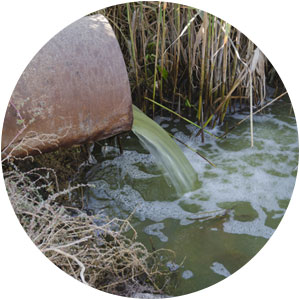
Discharges of domestic sewage into the ground can impact groundwater, and even drinking-water quality, in areas with no mains sewage network.
The problem with sewage going to ground
In parts of the UK (such as South East England) the groundwater from principal aquifers supplies 80% of public drinking water.
Alongside agricultural sources such as fertilisers, manures and landspreading, non-mains drainage (NMD) is thought to contribute to ammonium inputs.
The greatest risk to groundwater is in areas of high groundwater vulnerability, including protection zones that safeguard the quality of drinking water such as:
- Source protection zones (SPZ)
- Safeguard zones (SGZs)
- areas underlain by principal aquifers.
The impact of elevated nitrate (above drinking water standard 50 mg/L) on groundwater quality is a particular problem in the Chalk aquifer.
The rule of law
Sewage discharges of more than 2,000 litres per day from septic tanks or small packaged treatment plants (PTPs) are generally regulated through environmental permits.
The risks to groundwater quality must be assessed following Environment Agency guidance before a permit can be obtained.
It is likely that NMD rural communities and permit clusters have a cumulative impact on groundwater quality and water supplies, but it is not easy to quantify this.
UK law protects groundwater, and water resources in general, through the following:
- The Water Framework Directive 2000/60/EC (WFD) of the European Parliament and of the Council. This
established a framework for Community action on water policy.
http://ec.europa.eu/environment/water/water-framework/index_en.html - The Groundwater Directive 80/68/EEC (GWD), and Groundwater (England and Wales) Regulations 2009. These aim to protect groundwater from pollution by controlling discharges and disposal of certain dangerous substances.
- The Environmental Permitting (England and Wales) Regulations 2010 SI 2010:675. These relate to the regulation of discharges to controlled waters (including groundwater). Under the regulations, ‘groundwater activities’ relate to inputs of pollutants to groundwater.
- The National Groundwater Protection: Policy and Practice (GP3) This core groundwater policy of the Environment Agency aims ‘to protect and manage groundwater resources for present and future generations in ways that are appropriate for the risks that we identify’ www.environment-agency.gov.uk
NMD rural communities annual ammonium input
In NMD rural communities, each property is expected to discharge its wastewater to ground or surface water through an onsite wastewater treatment system (OWTS).
Domestic wastewater effluent concentrations of nutrients (total nitrogen and total phosphorus) depend on the OWTS installed, its efficiency and level of maintenance (for instance desludging).
For groundwater risk assessments, the EA proposes to use wastewater effluent ammoniacal nitrogen (as N) concentrations of:
- 50mg/L for septic tanks (STs)
- 20mg/L for package treatment plants (PTPs).
The annual nutrient load contribution through treated sewage discharges to ground from NMD communities is considered to be locally significant, based on:
- the number of properties
- the number of equivalent persons (PE) living in each property (2PE)
- average water usage (150L/d/PE).
A small NMD community of 50 properties (100PE) has an estimated annual ammoniacal nitrogen load of 292kg (8g/day/PE).
NMD communities in SPZ areas pose a particular risk to drinking water abstractions.
Reducing the risk
New developments should be connected to the mains sewer network. If this is not possible, sewage needs to be treated through an effective OWTS. An environmental permit is likely to be required, specifying discharge limits.
Appropriate OWTS selection and drainage-field design for new developments (or property alterations) require:
- professional assessment of wastewater flows and loads
- hydrogeological risk assessment
to ensure that the treated sewage has no significant impact on groundwater quality and surrounding water features.
If hydrogeological risk assessment identifies an unacceptable risk to groundwater quality, the OWTS can be upgraded to a higher treatment standard and/or flows limited.
The last word
WHS provides environmental consultancy services for the full water cycle, including obtaining bespoke environmental permits for discharges and groundwater activities.
Our Water services also include:
- drainage design
- quantifying flows and loads
- qualitative and quantitative hydrogeological risk assessment for controlled waters.
We have detailed knowledge and understanding of catchment hydrology, hydrogeology, environmental impact assessment.
Most importantly, we know how the regulators work.